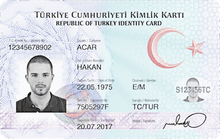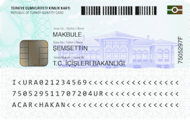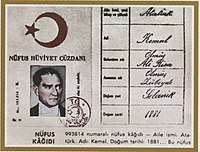Turkish identity card
The Republic of Turkey Identity Card (Turkish: Türkiye Cumhuriyeti Kimlik Kartı) is compulsory for all Turkish citizens from birth. The Turkish police are allowed to ask any person to show ID, and refusing to comply may lead to custody. It can be used as a travel document to enter Northern Cyprus,[2] Georgia (since 2011),[3] Moldova (since 2019)[4] and Ukraine (since 2017)[5] instead of a passport.
| Turkish identity card | |
|---|---|
 Republic of Turkey Identity Card (obverse) | |
 (reverse) | |
| Type | Identity card |
| Issued by | |
| Purpose | Proof of identity |
| Valid in | |
| Eligibility | Turkish citizenship |
| Expiration | 10 years |
| Cost | TRY25[1] |
History
Identity cards, theoretically obligatory for all citizens, male and female, existed already in the late Ottoman Empire. They were known in Turkish as nüfus tezkeresi.[6] To the Slavic subjects of the Ottoman state they were known colloquially as nofuz (Bulgarian: нофуз).[7][8]
ID cards (1927-1991)
Turkey issued ID cards (Turkish: Nüfus Hüviyet Cüzdanı) with the 1927 census in Ottoman Arabic letters. With Turkey's change to Latin script, ID cards were changed to Latin in 1928. Surnames were added after 1934, with the Surname Law. Newer ID cards were issued in 1976, however old cards were still valid until 1991.
ID cards (issued 1976-2017, still valid)
Turkey issued ID cards (Turkish: Nüfus Cüzdanı) for all citizens beginning in 1976. The cards are 7x9 cm in size and have gender specific color (Orange/red for females, blue for males). Starting from 1999, cards were issued with a Turkish Identification Number. Cards have an embossed stamp for security.
Starting in 2017, ID cards stopped being issued. The government extended the deadline for the validity of existing cards to 2023.[9]
New identity cards (2017-current)
The Turkish Ministry of the Interior issued an EU-like identity card (Turkish: Kimlik Kartı) for all Turkish citizens. New identity cards as well as passports are biometric, and can be used as a bank card, bus ticket or for international trips. Starting from 2 January 2017, these new ID cards were issued throughout Turkey. [10] Unlike previous cards, which were valid for life, new cards are only valid for 10 years. They are in ID-1 (credit card) size, smaller than the previous cards. The cards are gender-neutral for all citizens.[11] Cards are bilingual, both in Turkish and English. Although not active yet, e-signatures can be installed into the card's chip. The cards have PIN codes for authorization.
During the application for new cards, fingerprints for all fingers and palm vein prints are collected and associated with the person. New cards require biometric photos (for ages 15 and up) and have an individual’s signature. The new cards also omit several pieces of information found on previous cards, such as; marital status, religion, blood type, place of issue, previous surname (for females), hometown (State, District, Village) and register numbers (volume, family and line numbers).
See also
Notes
- https://randevu.nvi.gov.tr/pages/applicationprices
- http://mfa.gov.ct.tr/consular-info/visa-regulations/
- http://www.mfa.gov.tr/relations-between-turkey-and-georgia.en.mfa
- "Passport-free travel between Turkey, Moldova". Retrieved 28 February 2019.
- http://mfa.gov.ua/en/consular-affairs/entering-ukraine/visa-requirements-for-foreigners
- Chris Gratien, Ottoman Identity Card; includes images of the cards
- Kunchov, Vasil (1900), Makedonii͡a (in Bulgarian), Sofia: Bulgarskoto Knizhevno Druzhestvo, p. 135
- http://ekimlikrandevu.com/wp-content/uploads/2016/02/e-kimlik-randevu-alma-2.jpg
- "Sık Sorulan Sorular - NVI". randevu.nvi.gov.tr. Retrieved 16 January 2020.
- http://ekimlikrandevu.com/wp-content/uploads/2016/02/e-kimlik-randevu-alma-2.jpg
- "Ehliyet yenileme ücreti ne kadar? (Ehliyet yenileme işlemleri)". NTV. Retrieved 21 January 2017.

